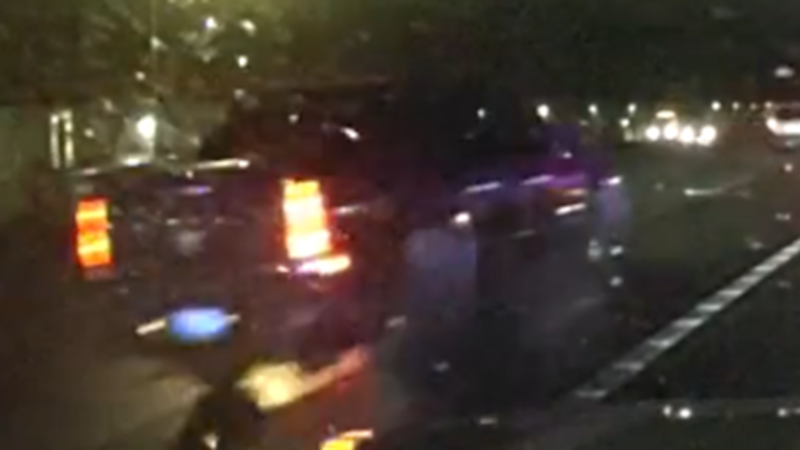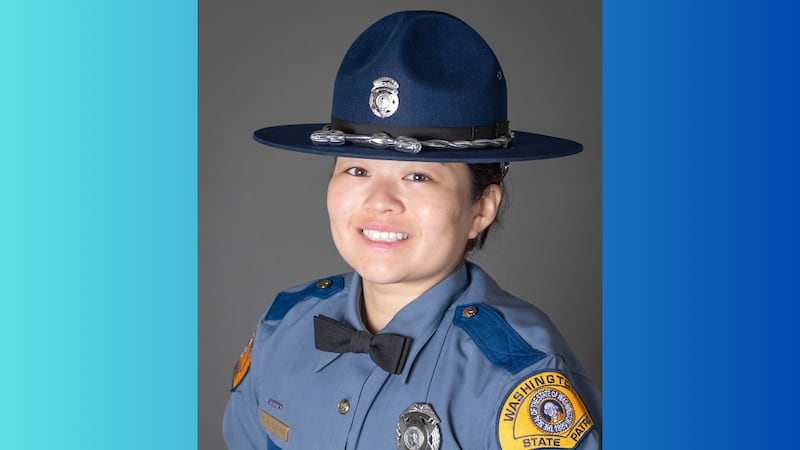Tacoma's most shameful day had plenty of villains. It also had others who tried to stop what became known as "The Tacoma Method."
That was the name given to the forced expulsion of 700 Chinese immigrant laborers and the burning down of Tacoma's Chinatowns on Nov. 3, 1885.
New details about that time came to light in late October when a diary by a first-hand observer was donated to the Tacoma Historical Society.
The laboring men say the Chinese shall go tomorrow," John C. Weatherred wrote in a flourished script on Nov. 2, 1885. "This whole movement has been one of violence from the start. This is one terrible town at present."
Weatherred was a Tacoma banker, post master and civic leader. His leather-bound diary was donated by his descendants.
Weatherred's first-hand accounts of events leading up to and following the expulsion are priceless, said THS curator Brendan Balaam.
"He was known for keeping very detailed notes about everything that happened in his life," Balaam said.
The 5-by-8-inch black, leather-bound diary is a valuable addition to the events surrounding the expulsion. Little was recorded leading up to the event other than inflammatory newspaper stories, Balaam said.
It also documents the temperament of Tacoma's citizens.
"It's amazing to read the context," Balaam said. "You have massive amounts of people coming together in the city at night, holding torches, preparing an act of ethnic cleansing right here in Tacoma."
Dusty Gorman, a librarian and historian at the University of Puget Sound, said the find adds another voice to the historical record. She co-created a digital history site on the expulsion.
"We haven't really heard that other side, from a citizen of Tacoma," she said. "It backs up what the affidavits of the Chinese said."
The Historical Society has transcribed key parts of Weatherred's diary. They are presented in this story in italics.
Scroll down to continue reading
More news from KIRO 7
- WATCH: Fife QB Brynna Nixon throws TD in playoff win
- 2 children killed, 1 injured in fire at Lynnwood apartment, fire officials say
- Krispy Kreme tells college student it's time to stop reselling the doughnuts
- Florida woman, 8 months pregnant, uses AR-15 to fatally shoot armed intruder
- Do you have an investigative story tip? Send us an email at investigate@kiro7.com
HARD TIMES
Anti-Chinese sentiment dominated the West from 1850 to 1906. In 1882, the Chinese Exclusion Act prevented immigrants from returning to the United States after visiting their home country. The Geary Act of 1892 required Chinese to wear identification tags or face deportation.
Several cities in the region sent delegates to a convention in Seattle. Tacoma sent more than any other city, Gorman said.
Sunday, Sep. 27, 1885
"The delegates elected to the Seattle Anti-Chinese Convention leaves for Seattle this evening. They seem to be elected on the Chinese must go platform. I have had nothing whatever to do with the move & do not think I shall because it seems to be more or less unreasonable in its demands."
In Tacoma, Chinese worked in laundries, small stores, sawmills, restaurants and hotels. They took low wages in economically hard times. That made them competition in the eyes of white Tacomans.
Monday, Sep. 28, 1885
"There is considerable agitation in the Sound Country now over the Chinese. There seems to be a determination on the part of the laborers to drive the Chinamen out."
A day later, Weatherred noted, a "good deal of lawlessness backing this thing up, I think."
Thursday, Oct. 1, 1885
"You meet a great many fools on the anti-Chinese subject. I rather feel like taking up for the underdog in the fight — the Chinaman sets some examples that is worthy of immitation (sic.) by white laborers, such as industry, economy, & sobriety. &C But they will likely go from here through fear."
Some families did leave in October ahead of a Nov. 1 deadline imposed by the Seattle convention. But, many stayed, asking to be compensated for possessions they would have to leave behind. Their requests were rebuffed.
Like an 1800s version of today's social media, information flowed from person to person, which in turn ignited fierce debates and drew groups together on street corners.
Friday, Oct. 9, 1885
"… After dinner I go down on the street to P.O. The people gather in groups on the street to talk over the Chinese question which seems to be the all absorbing topic of conversation. I have quite a talk with old man A. Macready. He is finatically (sic.) anti-Chinese – I differ with him which is sufficient to set him a going. A group of a dozen gather around us. …"
Newspapers, the only media of the day, were drawn into the controversy in 1885.
Friday, Oct. 30, 1885
"The papers are still cooking up the Chinese question here. The Ledger is cooling off. The News is still acting the fool, abusing everybody that may differ with them on the question. They seem to have a special spite against Rev. McFarland & Ezra Meeker — in fact anybody who differs."
Puyallup pioneer Ezra Meeker and Rev. W.D. McFarland, a Presbyterian pastor, were vocal opponents of the planned Chinese expulsion. Newspapers pushed back at McFarland.
The deadline for expulsion came and went. Some Chinese left. Many stayed.
Then, on Nov. 3, city leaders —including Mayor Jacob Weisbach and a couple future mayors — took action. They became known as Tacoma's 27. The operation was planned down to the smallest degree, Gorman said.
Tuesday, November 3, 1885
"Chinese driven out of Tacoma today
Then the fire bells begin to ring which is the signal for the Anti-Chinese mob to move on the Chinese and (force them) out of their houses and make them leave. So about 3 of, (they) congregate & move & force the Chinese to pack up. Leave 3 or 4 of the mob at each house to see that they pack up. And in afternoon, come along and march the Chinamen before them to Lake view 9 miles. The mob puts their chattels to (sic) heavy to carry by Chinamen in Wagons and hauls them out to Lake view but few Chinamen are left tonight. & they have to leave inside of 24 hours. (Such moxie.)"
Lakeview is an area near today's Interstate 5 and Bridgeport Way Southwest. The Chinese were put aboard trains there.
Wednesday, November 4, 1885
Everybody is talking about the manner in which the Chinese were driven out of Tacoma yesterday. The Tacoma News says there was no violence in doing it which was a lie —Because the Chinese were ordered out of their houses made to pack up and escorted out of the city. Driven out by force and violence I call it. The extreme anti-Chinese think they have done something wonderful by making them go. They acted about as a mob usually acts. I think a large majority of this town are opposed to this extreme move yet say but little. Thoroughly intimidated and bulldozed.
In the days that followed, Tacoma's two Chinatowns were burned — one near Old Town and the other near today's grain terminal on Schuster Parkway. Weatherred lay the blame on agitators. They, in turn, blamed the remaining Chinese.
"Yet they lay it to the Chinese and have had three Chinamen arrested for setting the fire," Weatherred wrote on Nov. 5. "Must put the blame on someone (other) than themselves."
Within days, a U.S. marshal arrives in Tacoma and "summons several persons to go before the U.S. Grand Jury in session at Vancouver. Likely some of the agitators will be arrested, which they ought to be."
On Nov. 7, U.S. troops move through Tacoma but don't stop. Agitators are feeling the heat, Weatherred wrote.
"They are much worried because they know they are guilty of violating the law," he wrote. "The agitators are very overbearing to everyone who says the least thing against their extreme move. Set of crazy fools mostly."
"The Tacoma Method" became famous because of its heartless success.
"Tacoma's was the first one planned and executed," Gorman said. "It was all very systematic."
AFTERMATH
None of the 27 were convicted. They stayed in civic power for at least another decade, Gorman said.
Though many, like Weatherred, decried the expulsion, the group of 27 were hailed as heroes by many.
A Chinese witness at the trial said two people had died overnight at the Lakeview station, Balaam said. They also reported violence, contradicting what the agitators and newspapers said.
In the 1990s, the late Tacoma pastor David Murdoch called the incident a "moral wound" that had never healed. He was instrumental in creating the city's Chinese Reconciliation Park.
The 3.9-acre park on Schuster Parkway near North 30th Street opened in phases from 2010 to 2012. Today it serves as a memorial and a remembrance to the events of Nov. 3, 1885, a landscaped oasis between Commencement Bay and the railroad tracks.






